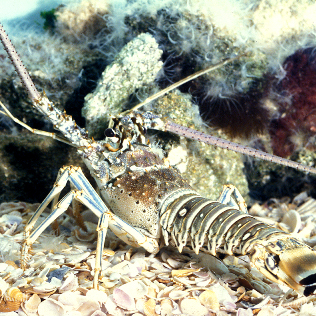 The Whitney Laboratory for Marine Bioscience
The Whitney Laboratory for Marine Bioscience


Dr. Barry Ache obtained a B.S. in biology at Albright College and an M.S. in behavior at the University of Illinois Urbana-Champaign. He earned his Ph.D. in behavioral physiology at the University of California, Santa Barbara in the Department of Biological Sciences.
Email: bwa@whitney.ufl.edu

Our research program is centered in two UF locations. One laboratory is located at the Whitney Laboratory in St. Augustine and the other at the McKnight Brain Institute on the main campus in Gainesville. Research associates and graduate students can work at either location.
Our laboratory studies olfaction – the sense of smell. The common theme that runs through our research is sensory coding – how information about the sensory environment, the odor world in our case, is encoded by the nervous system. We address these questions primarily through electrophysiological approaches, but also integrate molecular, biochemical, and, through collaboration, computational modeling approaches. In recent years our research has focused on sensory coding in the olfactory periphery, using both arthropod (lobster, insect) and mammalian (mice, rats) animal models. Much of this research centers on understanding mechanisms of olfactory transduction – the process by which primary olfactory receptor cells convert odor signals into the electrical signals the brain uses to process information.
Disruption of any aspect of olfactory transduction potentially can disrupt olfactory function in both humans and animals. Understanding olfactory dysfunction, therefore, requires elucidating the full range of steps involved in olfactory transduction. For example, olfactory receptor neurons in arthropods, including those of insects such as mosquitoes that are vectors for major human diseases such as malaria and Dengue fever, signal through ionotropic olfactory receptors. Disruption of any olfactory signaling component associated with ionotropic receptor-mediated olfactory transduction can potentially disrupt olfactory function, and therefore host-finding, in insect vectors for major human disease.
Phosphoinositide 3-kinase dependent inhibition as a broad basis for opponent coding in mammalian olfactory receptor neurons
Our main project explores the role of phospholipid signaling in mammalian olfactory transduction. In particular, we focus on how a specialized group of membrane lipids, collectively known as 3-phosphoinositides, modulate (inhibit) the output of mammalian olfactory receptor cells. They appear, at least in part, to target the well known cyclic, nucleotide-gated ion channel in these cells. In our most recent work, to better understand the breadth of such inhibition in odor coding, we screened a panel of odorants representing different chemical classes, as well as odorants known to occur in a natural odor object (tomato), for their ability to rapidly activate PI3K-dependent inhibitory signaling. Odorants were screened on dissociated native rat ORNs before and after pre-incubation with the PI3K-isoform specific blockers AS252424 and TGX221. Many different odorants increased their excitatory strength for particular ORNs following PI3K blockade in a manner consistent with activating PI3K-dependent inhibitory signaling in those cells. The PI3K-dependent inhibitory odorants overlapped with conventional excitatory odorants, but did not share the same bias, indicating partial partitioning of the odor space. Difference in the tuning of individual ORNs to odorants evoking PI3K-dependent and those evoking conventional excitatory responses is consistent with binding to different sites on the OR. Finding that PI3K-dependent inhibition can be activated by a wide range of otherwise conventional excitatory odorants strongly implies PI3K-dependent inhibition provides a broad basis for opponent coding in mammalian ORNs.
Interestingly, this project grew out of some of our earlier work with lobster olfactory receptor cells that for the first time implicated 3-phosphoinositides in olfactory signaling. This project serves as an example of the utility of marine biomedical research – how research on a marine animal model can generate information of utility to better understanding, and treating, human health.

Characterization and expression of lobster olfactory variants of ionotropic glutamate receptors
The molecular basis of olfactory signal transduction in crustaceans, a major group of arthropods, is still uncertain, in particular the nature of the olfactory receptors. We have cloned and analyzed full length sequences of multiple orthologs of Drosophila olfactory variants of ionotropic glutamate-like receptors (IRs) from the lobster olfactory organ. Odorant-induced responses from HEK cells heterologously expressing a combination of two IRs, 1 and 2, indicate that lobster IRs can form functional odorant receptors and suggests that, as in insects, they function as heteromers. Unlike the IR expression pattern in insect olfactory receptor neurons (ORNs), most, if not all, lobster ORNs express IR1 (ortholog of Drosophila IR25a), as confirmed by in situ hybridization. IR1 can be further localized to the transduction compartment (outer dendrites) of the ORNs by western blotting and immunocytochemistry. While IR1 appears to be a common subunit, other IRs are expressed in very few ORNs, suggesting specific receptor function. Characterizing the receptive range of lobster ORNs in situ using calcium imaging shows that single biologically-relevant odorants, e.g., amino acids, trigger calcium increase in only 0.3-6% ORNs, consistent with the IR expression pattern. In the context of long-standing evidence for odorant-activated metabotropic signaling in lobster ORNs, expression of IRs in the same cells argues that ionotropic and metabotropic signaling work in concert to effect lobster olfactory transduction.
We now appreciate that olfactory receptors in all arthropods are ionotropic receptors that function as ligand (odorant)-activated ion channels. Controversy exists as to exactly how ionotropic receptors function in olfactory transduction in insects, in particular whether they act in part by regulating metabotropic signaling. Given the potential of controlling insect disease vectors through their sense of smell, it is critical to fully understand olfactory signaling in arthropods. Lobster olfactory IRs allow us to do this in an arthropod model in which there is compelling evidence that ionotropic olfactory receptors can drive metabotropic signaling.
A neural substrate for olfactory scene analysis
In collaboration with Dr. Jose Principe (Electrical Engineering, University of Florida) we are exploring the functional role of a novel subpopulation of olfactory receptor neurons. There is no understanding of what strategy might be utilized by the olfactory system to capture signal intermittency. We show through computational modeling that a subset of bursting primary olfactory receptor neurons, or bORNs, have the unexpected capacity to encode the temporal properties of intermittent odor signals. Based on differences in their inherent rate of bursting discharge and the phase dependency of their response to odor stimulation, each bORN is tuned to a specific range of stimulus frequencies. Those bORNs that fall within a given range of inherent bursting frequency are entrained by the odor intermittency. Collectively, bORNs can encode a wide spectrum of stimulus intermittency that can be decoded from the instantaneous response of the bORN population. Our model argues for the existence of a novel peripheral mechanism for encoding temporal pattern of odor signals that potentially serves as a neural substrate for olfactory scene analysis.
Our research has been primarily supported by the National Institute on Deafness and Other Communication Disorders (NIDCD). We are sincerely grateful to be able to help address important questions in the mission area of the Institute. More recently, our research has been supported by the National Science Foundation.